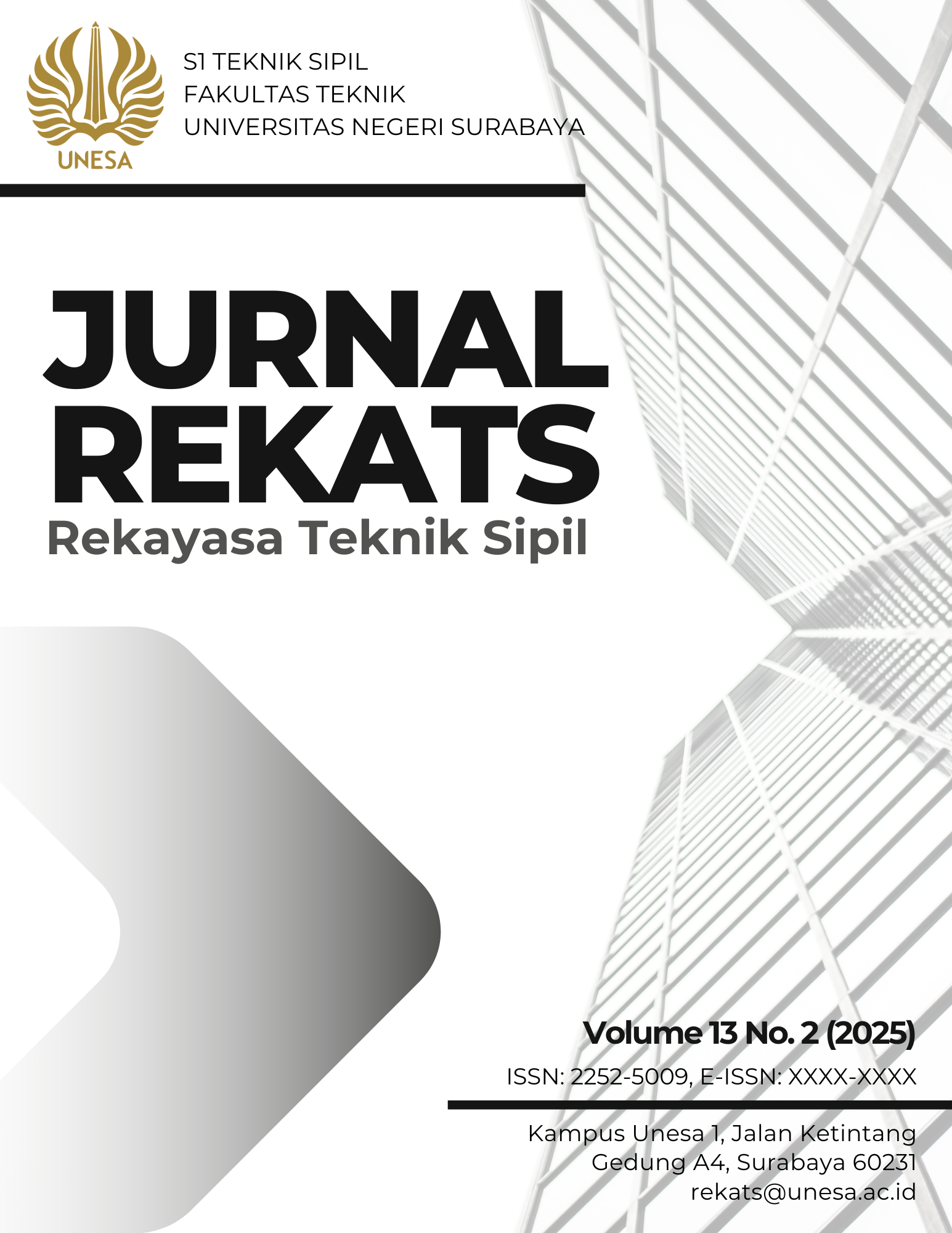ANALYSIS AND PLANNING OF CLEAN WATER DISTRIBUTION SYSTEM OF SUMBER TOWO SPRING, SELOTAPAK VILLAGE
DOI:
https://doi.org/10.26740/rekats.v13n02.p393-403Keywords:
Clean water distribution, epanet, headloss, spring, velocityAbstract
Clean water is a crucial necessity for society. The Sumber Towo spring in Selotapak Village provides safe water for domestic and non-domestic use. However, the water distribution infrastructure is often inadequate, with issues such as pipe leaks and uneven distribution. This study aims to analyze clean water distribution using Epanet software. The research method employs a quantitative descriptive approach. The findings using Epanet 2.2 indicate a head loss of 17.83 m/km, which should be ≤10 m/km, and the lowest velocity recorded at 0.05 m/s, below the standard requirement of 0.3–0.6 m/s. Therefore, the head loss and velocity do not meet the standards set by SNI 03-7065-2005 and Permen PU No.18 of 2007. Consequently, a redesign of the clean water network is necessary. The study results suggest an elevation increase of 8 meters in the reservoir, from +651 meters to +659 meters, as well as a pipe diameter modification, which successfully reduces the highest head loss to 9.47 m/km from 17.83 m/km and increases the velocity to 0.4 m/s from 0.05 m/s. Thus, this analysis aligns with the standards set by SNI 03-7065-2005 and Permen PU No.18 of 2007.
Downloads
References
Afdillah, R., & Nusantara, D. A. D. (2022). Evaluasi Jaringan Perpipaan Distribusi Air Bersih Dusun Jaten Desa Selotapak Kecamatan Trawas Kabupaten Mojokerto Menggunakan Epanet 2.0. Rekayasa Teknik Sipil, 9(1).
Alkali, A. N., Yadima, S. G., Usman, B., Ibrahim, U. A., & Lawan, A. G. (2017). Design of a Water Supply Distribution Network Using Epanet 2.0: a Case Study of Maiduguri Zone 3, Nigeria. 13(3), 347–355. www.azojete.com.ng
Chandra Astiti, S. (2023). Penerapan Metode Least Square Dalam Perhitungan Proyeksi Jumlah Penduduk. Sepren, 4(02), 147–154. https://doi.org/10.36655/sepren.v4i02.1131
Galeh, L., Fatristya, I., Saimah, W., Hadi, I., & Aryanti, E. (2025). Peran Air Bersih dan Sanitasi dalam Meningkatkan Kualitas Hidup : Tinjauan Literatur terhadap Pencapaian Tujuan SDGs 2030. 6(1).
Kause, M., Frans, J. H., & Utomo, S. (2020). Evaluasi Dan Perencanaan Pengembangan Jaringan Air. Jurnal Teknik Sipil, IX(2), 255–268.
Permen PU No.18. (2007). Penyelenggaraan pengembangan sistem penyediaan air minum. ciptakarya.pu.go.id/dok/hukum/permen/permen_18_2007.pdf
Primantari, P., Suari, V., Putri, S., & Astiti, C. (2025). Analisis Proyeksi Kebutuhan Air Domestik dan Non Domestik pada Wilayah Kecamatan Penebel Kabupaten Tabanan. 06(02), 833–842.
Purwanto, E. W. (2020). Pembangunan Akses Air Bersih Pasca Krisis Covid-19. Jurnal Perencanaan Pembangunan: The Indonesian Journal of Development Planning, 4(2), 207–214. https://doi.org/10.36574/jpp.v4i2.111
Sharma, M. K., Khanal, S. P., & Adhikari, R. (2022). School Water, Sanitation, and Hygiene: A Systematic Review of an Effect on Health, Attendance, Regularity, and Educational Achievements. Scholars’ Journal, 5(December), 1–21. https://doi.org/10.3126/scholars.v5i1.55744
SNI-03-7065-2005. (n.d.). Tata Cara Perencanaan Sistem Plambing.
Yang, D., He, Y., Wu, B., Deng, Y., Li, M., Yang, Q., Huang, L., Cao, Y., & Liu, Y. (2020). Drinking water and sanitation conditions are associated with the risk of malaria among children under five years old in sub-Saharan Africa: A logistic regression model analysis of national survey data. Journal of Advanced Research, 21, 1–13. https://doi.org/10.1016/j.jare.2019.09.001
Zaera, M. R. P. (2024). Faktor dan Dampak dari Peningkatan Urbanisasi di DKI Jakarta pada Tahun 2023. Jurnal Wahana Bina Pemerintahan, 6(1), 38–42. https://doi.org/10.55745/jwbp.v6i1.167
Downloads
Published
Issue
Section
 Abstract views: 81
,
Abstract views: 81
, PDF Downloads: 0
PDF Downloads: 0





